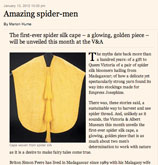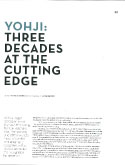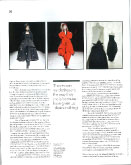In conversation with Nike’s Hannah Jones, the brand’s Chief Sustainability Officer and Head of Innovation. April 20th 2018. The Victoria & Albert Museum, London.
Tag Archives: V&A
Amazing spider-men – The Financial Times
Amazing spider-men
The first-ever spider silk cape-a glowing, golden piece-will be unveiled this month at the V&A
The Financial Times | 15th January 2012
By Marion Hume
The myths date back more than a hundred years: of a gift to Queen Victoria of a pair of spider silk bloomers hailing from Madagascar; of how a delicate yet spectacularly strong yarn found its way into stockings made for Empress Josephine.
There was, these stories said, a sustainable way to harvest and use spider thread. And, unlikely as it sounds, the Victoria & Albert Museum this month unveils the first-ever spider silk cape, a glowing, golden piece that is as much about two men’s determination to work with nature as it is a desire to make fairy tales come true.
Briton Simon Peers has lived in Madagascar since 1989 with his Malagasy wife Ange and their two sons. He gave up a job as an art dealer at the Fine Art Society in London to move to the Malagasy capital Antananarivo (known as “Tana”), to reinvigorate the business of Madagascar’s exquisite silk traditions (this from silkworms, not spiders). He imported looms from Yorkhire to create jacquards, passementerie and embroidery of Versailles standards of craftsmanship. The world’s leading decorators, including Peter Marino, Robert Couturier and David Mlinaric, have become loyal customers.
Peer’s partner is American Nicholas Godley, whose grandmother was born in Madagascar. He arrived in 1993 as a development economist to work on raising living standards in one of the world’s poorest countries. Then he set up a handbag label, Majunga, employing hundreds and using native raffia,and sold bags to Neiman Marcus and Saks.
Peers and Godley had been friends for years when, one day in 2003, Godley asked about a strange contraption on a shelf in Peers’ office. “I told him it was for extracting silk from spiders,” recalls Peers. Godley was more than intrigued; he was determined to push Peers to turn a daydream into reality.
Peers was obsessed with the island’s large female golden silk orb-weaver spider (Nephila madagascariensis), famous for creating the most symmetrical and concentric of spider webs. He’s come a tale of how Paul Camboue, a French Jesuit priest, had tried to extract spider silk and how these efforts had attracted the attention of a 19th-century French colonial administrator called Nogue (his first name lost to history), who was looking for industries to set Madagascar apart from other francophone colonies. It was Nogue who had designed the machine Peers had on his shelf- a guillotine-like trap (although its occupants emerge unharmed) that could hold eight spiders while the threads were pulled from their bodies on to a bobbin.
“Think of the times you have brushed a spider off your sleeve,” Peers says. “You flick and it falls but is still attached to you by a silken thread. The silk comes out without any problem.”
At the end of the 19th century, such was the excitement about the possibilities for spider silk that spider catching was considered a top job for locals in Antananarivo. There was even a technical college there, set up to train spider silk weavers. In 1900 a set of Malagasy spider silk bed hangings, now lost, was exhibited in Paris. But enthusiasm waned, not least because of hte challenges of lodging and feeding hundreds of thousands of carnivorous cannibals needed for every yard of silk. Spider silk also turned out to be at least 2o times more costly than the “boil in the bag” method by which silkworms dies to release a strand of thread.
A century on, however, Peers and Godley decided to give it another try. In 2004, they started “silking” spiders and by Novermber 2008, the elusive silk became reality. “Having silked over a million spiders, we are transforming the resulting stock into a singer unique and extraordinary golden textile,” Peers says.
The challenge of food and lodging was solved by using only females, brought to the silking facility each morning by a team of 80 spider catchers and then released into the wild later that afternoon.
In 2009, Peers emailed me to say: “We are making this extraordinary cape. Homage to the spider. And apart from another-probably apocryphal story-of a suit of spider silk clothes made for Louis XIV, this will be the first time any serious piece of clothing has ever been attempted.”
Three years on, he calculates that the weaving, embroidery and applique of the cape has involved 6,000 human hours, while at least 1.2m spiders have been employed. Each of the hundreds of thousands of warp and weft threads comprises 96 individual strands of spider silk in the ground weave of the decorated panels and 48 individual strands for each thread in the lining. each pass of the needle to create the embellishments of appliqued spiders scuttling over flowers required 96 strand threads. The golden glow is the natural colour of the silk.
Peers and Godley have no ambition to find a more industrial application for their breakthrough. “Our objective has not been just conquering the technical challenges, but also to engage people with an emotional and intellectual experience,” says Peers. “This lengthy and arduous process is the antithesis of the brief, ephemeral life of a web.” The result, they hope, will live on, and not just in stories.
‘Golden Spider Silk’, V&A Studio Gallery, January 25-June 5
Yohji Yamamoto – Sunday Telegraph
Sunday Telegraph Fashion Magazine | 20th March 2o11
Yohji Yamamoto
by Marion Hume
The question is not why is Yohji Yamamoto the subject of a major fashion retrospective at the V&A this spring, but what took so long?
For it is now 30 years since Yohji (always called Yohji, not Yamamoto by fashion insiders), along with Rei Kawakubo of Comme des Garcons, stormed the bastions of French fashion. It was shocking.
To say one is “shocked” can be used casually in fashion-speak these days. But in March 1981, the front row set were truly appalled. They were, already, in a jumpy mood before the first Yohji Yamamoto show began. The chill wind of President Mitterand’s newly elected socialist regime was blowing through the silken corridors of Paris fashion, where the motto is rarely Liberte, Egalite, Fraternite, but at least they expected to be on somewhat familar ground, to see more of the coquettish frills and furbelows of the likes of Valentino and Ungaro. Instead what they were confronted with was oversized, flawed, monochromatic, flat-heeled, gender neutral, asymmetrical, shabby looking clothes. “Is there a “yellow peril” on the horizon?” thundered Le Figaro. Not a line one could get away with now.
While the first to be accused of “Holocaust chic”, Yohji Yamamoto and Rei Kawakubo were not the first Japanese designers on the Paris fashion scene. Hanae Mori had established a gracious reputation for neat little suits, Kenzo had made his Jungle Jap shows into extravaganzas, Issey Miyake had been showing in Paris since 1973. But the storm caused by Yamamoto and Kawakubo didn’t die down, it got more fierce. By 1983, Le Figaro was still raging. telling readers, “this miserable-ism is not for you. Neither are these patched garments, nor these new rags, nor these fabrics tied hastily as tatters. Nor all this funereal black. Nor the livid make-up of decomposed women. A snobbism of rags that presents the future in a bad way.”
From the beginning, the British were more curious. Joan Burstein of Browns and the late Joseph Ettedgui of Joseph were quick to see the possibilities of the new wave. (Browns landed Comme des Garcons, the Joseph stores carried Yohji). British fashion students, who back then would travel by coach and ferry to Paris and beg, borrow or steal tickets to shows, were also early fans. Some recall finding their way to Yohji’s Paris studio after the first show and being shown textures and shapes completely new to the West. British Vogue also soon realised this was the aesthetic of the future, praising the designers of the “International East” “for their noblesse oblique, thunderstruck colour, marvellous new manipulations of print and texture.”
Part of the savagery of the initial reaction from the old guard must be attributed to the prejudice of those just one generation away from war. As for Yohji Yamamoto himself, he is defined by the circumstances of his birth, to a widowed mother, who would work 16 hours a day to raise him. In 1987, he said this in an interview with Sally Brampton, then one of the UK’s leading fashion scribes, now an agony aunt; “The reason my clothes (are the way they are) is because I have given up, because I desire nothing. Some people try to relate that to Buddhism but it has nothing to do with it. It is hard to appreciate what I say unless you were born in Tokyo in 1943 when the war was destroying everything. Success came just by chance. I never wanted anything. Like most of my generation in Japan, I didn’t want to do anything or be anyone, so I started to help my mother in her dress shop. I hated it.”
A lifelong love of rock n roll might seem to sound a lighter note (and led to a bizarre show where male models walked to “Ain’t Nothing but a Hound Dog” played on a bazooka), yet Yohji himself has been somber about “Americanization.” “We were fed American products but at a certain age you start realizing things. The problem was, who are the Japanese people?” he has said. “It is very difficult, even for us, to find out”.
Yet as time has gone on, Yohji has also, brilliantly and surprisingly, explored the aesthetic of Paris, where he sets up home for weeks every season (his mother comes too, to cook for him). Having first fought against the richness of haute couture, latterly he has subverted it. Who can forget Yohji’s catwalk bride with a gown so huge it swept the notebooks off the laps of those in the front row?
For all the memorable catwalk sensations, most of Yohji’s creations are rather plain, often navy and in industrial gaberdine which makes them seasonless. The same women who would not be seen dead in last season’s Prada happily boast of wearing “20 year old Yohji”, which explains why there is so little trade in Yohjis on the vintage market.
What his clothes have always explored is feminism. Never interested in coquettish appeal, his woman is always strong, although as he has concurred, “Most men do not like strong, independent women with their feet on the ground. Men don’t want women to be outstanding…. When women try to be real people there is tremendous pressure against them. I’d like to say hang on, keep trying.”
To do so, wearing timeless Yohji is a pleasure.








